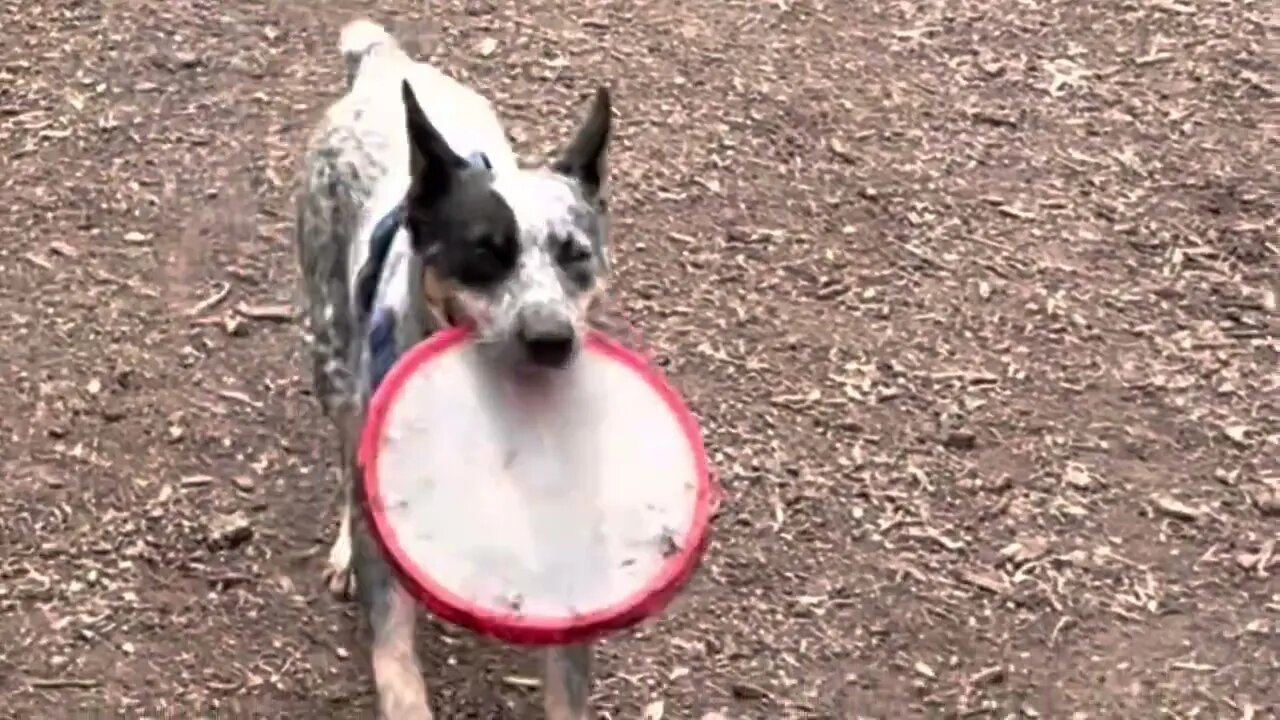Premium Only Content

Australian cow dog plays frisbee #cow #beef #cowdog #cattle #heeler #blueheeler #australiancattledog
The Australian Cattle Dog (ACD), or simply Cattle Dog, is a breed of herding dog originally developed in Australia for droving cattle over long distances across rough terrain. This breed is a medium-sized, short-coated dog that occurs in two main colour forms. It has either red or black hair distributed fairly evenly through a white coat, which gives the appearance of a "red" or "blue" dog.
As with dogs from other working breeds, the Australian Cattle Dog is energetic and intelligent with an independent streak. It responds well to structured training, particularly if it is interesting and challenging. It was originally bred to herd by biting, and is known to nip running children. It forms a strong attachment to its owners, and can be protective of them and their possessions. It is easy to groom and maintain, requiring little more than brushing during the shedding period. The most common health problems are deafness and progressive blindness (both hereditary conditions) and accidental injury; otherwise, it is a robust breed with a lifespan of 12 to 16 years.[1]
In the 19th century, New South Wales cattle farmer Thomas Hall crossed the dogs used by drovers in his parents' home county, Northumberland, with dingoes he had tamed. The resulting dogs were known as Halls Heelers. After Hall's death in 1870, the dogs became available beyond the Hall family and their associates. They were subsequently developed into two modern breeds: the Australian Cattle Dog and the Australian Stumpy Tail Cattle Dog. Robert Kaleski, who wrote the first standard for the breed, was influential in its development.
The first domestic dogs to arrive in Australia came with the First Fleet in 1788 and later convict fleets. A thriving stray dog population soon grew. Some of the strays, those with stock work potential, found home with the free settler, George Hall. Thomas Hall, a son of George, developed them into working dogs of excellence. Robert Kaleski, who wrote the first standard for the breed, called Hall's dogs Halls Heelers. The Halls Heelers were later developed into the two modern breeds, Australian Cattle Dog and Australian Stumpy Tail Cattle Dog.[2]
Australian Cattle Dog has been nicknamed a "Red Heeler" or "Blue Heeler" on the basis of its colouring and practice of moving reluctant cattle by nipping at their heels. Dogs from a line bred in Queensland, Australia, which were successful at shows and at stud in the 1940s, were called "Queensland Heelers" to differentiate them from lines bred in New South Wales; this nickname is now occasionally applied to any Australian Cattle Dog.
The Australian Cattle Dog is a sturdy, muscular, compact dog that gives the impression of agility and strength. It has a broad skull that flattens to a definite stop between the eyes, with muscular cheeks and a medium-length, deep, powerful muzzle. The ears are pricked, small to medium in size and set wide apart, with a covering of hair on the inside. The eyes are oval and dark, with an alert, keen expression. The neck and shoulders are strong and muscular; the forelegs are straight and parallel; and the feet round and arched, with small, sturdy toes and nails.[3]
The Australian Cattle Dog breed standard states that it should have well-conditioned muscles, even when bred for companion or show purposes, and that its appearance should be symmetrical and balanced, with no individual part of the dog exaggerated. It should not look either delicate or cumbersome, as either characteristic limits the agility and endurance that is necessary for a working dog.[3]
Size
The female Australian Cattle Dog measures approximately 43–48 centimetres (17–19 in) at the withers, and the male measures about 46–51 centimetres (18–20 in) at the withers. The dog should be longer than tall, that is, the length of the body from breast bone to buttocks is greater than the height at the withers, in a ratio of 10 to 9.[3] An Australian Cattle Dog in good condition weighs around 18–25 kilograms (40–55 lb).
-
 LIVE
LIVE
Bannons War Room
9 days agoWarRoom Live
21,520 watching -
 2:17:39
2:17:39
Matt Kohrs
11 hours agoBREAKING MARKET NEWS: Bounce or Bust?! || The MK Show
33.1K1 -
 47:26
47:26
BonginoReport
3 hours agoEpstein Files Drop Today-But How Much Will They Reveal? (Ep.149) - 02/27/2025
66.8K114 -
 LIVE
LIVE
Wendy Bell Radio
6 hours agoThe Left Is Wrong About Everything
10,521 watching -
 29:05
29:05
CatfishedOnline
19 hours ago $0.31 earnedThe Real Jennifer Aniston or Another Romance Scam?
16.4K9 -
 34:44
34:44
LFA TV
5 days agoMIRACLES DO HAPPEN!
65.5K3 -
 16:43
16:43
T-SPLY
4 hours agoCNN Panel Member Forgets Donald Trump Runs The Military
25.5K20 -
 31:13
31:13
World Nomac
23 hours agoAMERICAN visits IRAN for 10 days (this is what I found) 🇮🇷
23K3 -
 1:03:55
1:03:55
The Tom Renz Show
11 hours agoBongino In At FBI & Is Factory Meat Made of Cancer?
40.6K7 -
 7:03
7:03
Dangerous Freedom
18 hours ago $0.82 earnedBest Tiny Budget Red Dot? (Honest Review - Gideon Optics Judge).
23.5K2